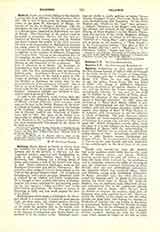

Baldred, Saint, (1) a Celtic Bishop of Strathclyde, b. about 643; d. at Aldhame, Haddingtonshire, about 607. He is said to have been the immediate successor of the great St. Kentigern, or Mungo, the founder of the See of Glasgow, Scotland. Like St. Kentigern, he was of Irish ancestry, but is reckoned as a British saint, inasmuch as Strathclyde was part of Britain. The chronology of the period when he flourished is somewhat obscure, but the best authorities on Scottish history agree that St. Baldred was born towards the middle of the sixth century. Previous to his consecration, St. Baldred had labored for many years in Strathclyde, and had founded numerous houses for monks as also for holy virgins in addition to the churches of Aldhame, Tyinguham and Preston Kirk. Owing to the disturbed state of the kingdom, he was forced after a short rule to retire from the spiritual government of the Strathclyde Britons as also happened to his predecessor. His feast is observed on March 6.
(2) BALDRED, or BALTHERUS, a holy hermit-priest of the eighth century, who has been confounded with the preceding Scottish saint. According to Simeon of Durham and Hovendeus the date of his death is given as 756. Turgot of Durham is more explicit, and he tells us that Baldred, or Baltherus, the priest, died “in the seventeenth year of the episcopate of Cynulf”, that is 756, or on the March 6, 757. This Baldred is associated with the See of Lindisfarne, and was an Englishman. Numerous miracles are ascribed to him, and his feast is given as March 6.
To add to the confusion, some writers have imagined that this Baldred is identical with Bilfritt, or Bilfrid, a hermit goldsmith, whose exquisite work may yet be seen in the British Museum on the cover of a Book of Gospels, generally known as the Gospels of St. Cuthbert. This cover was made during the rule of Bishops Eadfrid and Ethelwold of Lindisfarne, 698 to 740. The relics of St. Bilfrid were discovered by Aelfrid, and were placed, with those of St. Baldred, in St. Cuthbert’s shrine at Durham, but were subsequently transferred to the shrine of St. Bede in 1104.
W. H. GRATTAN FLOOD

